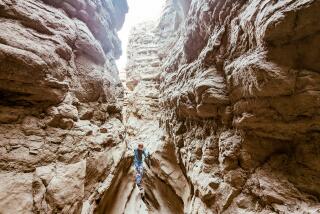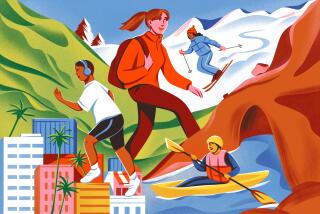Atop the Volcano : Exploration and camaraderie on the quiet island of Ometepe
- Share via
ALTA GRACIA, Nicaragua — As the ferry growled across the murky, white-capped waters, the island of Ometepe gradually transformed from a dark smudge on a gray horizon to a green, double-humped beast splayed across the water. It looked primeval, something out of Jurassic Park.
Ometepe’s two humps are volcanic. The taller, Volcan Concepcion, soars to a bare cinder cone; Volcan Madera rises nearby, it’s flanks swathed in dark jungle. Isolated in the Lago de Nicaragua (Nicaragua Lake), the world’s 10th-largest body of fresh water, Ometepe has been forgotten in the rush of modernization that is overtaking the rest of Central America. It lacks the Pizza Huts of Honduras, the 4x4s roaring through Costa Rican beach towns, the pyramid-shaped Hotel Inter-Continental in Managua, Nicaragua’s capital.
Ometepe, however, is not merely primitive. There is a sense that time has stopped on the island; as if the ancient petroglyphs that dot Ometepe were carved yesterday instead of a thousand years ago; as if the clouds hovering about Concepcion just wafted from its cone, though the volcano hasn’t erupted in more than 20 years. For visitors who explore its jungles, which teem with wildlife, or who wander its unsullied beaches and quiet villages, the island’s timelessness is palpable.
*
Ometepe’s volcanoes were separate islands until Concepcion erupted in 1804. Ensuing lava flows filled the gap, giving the island, which is the largest of the lake’s more than 300 islands (it’s about 15 miles long), a barbell shape. The volcanoes also provided the rich soils that give the island its dense, tropical vegetation and allow the island’s 30,000-or-so residents to grow a wide variety of crops, including bananas, corn, coffee and cotton.
Concepcion still erupts periodically, most recently in 1983. Not much else, however, seems to have happened on Ometepe in the last few decades. Automobiles are scarce, roads are unpaved, the most common vehicles are horse and ox-drawn carts--many fashioned from the rusted back ends and rear wheels of old pick-ups.
Boarding the bus that would take me from the ferry landing at Moyogalpa, one of the islands two main towns, to Alta Gracia, I noticed that this vehicle too was constructed of old auto parts. Its roof and walls, from an ancient school bus, were welded onto a flat-bed truck.
Though there were several hotels in Moyogalpa, I made the teeth-rattling, 1 1/2 hour journey to Alta Gracia to stay at Hospedaje Castillo, perhaps the most welcoming budget accommodation in all of Central America.
Operated by Ramon Castillo and his family, the Hospedaje (Guest House) Castillo charges only about $4 for a room, attracting almost every youthful budget traveler in Nicaragua. Besides being a tireless source of information about the island, Castillo, 81, looks after his guests like a grandfather brooding over his heirs.
He also serves food, though any meal at the Hospedaje Castillo is an exercise in stomach-growling patience. This may be intentional, however. Because there’s nowhere else to go while waiting for your broiled chicken or rice and beans, you sit for hours immersed in conversation with fellow travelers. Before long, joint explorations are planned and stays are extended.
*
Among my new acquaintances was Nick Ray, a seasoned traveler from London. While we waited for our food in Castillo’s wide courtyard, Nick explained why the most important piece of equipment a backpacker can have is a Frisbee.
“You can play with it, sit on it, use it as a plate or prop it up against a wall as a pillow,” explained Ray, who went on to describe a harrowing bus ride in India, where he became violently ill, couldn’t get to a window fast enough and quickly found another use for his Frisbee.
The next morning, Ray, his Frisbee and I took a short bus ride to the Finca Santa Domingo, a small hotel and restaurant fronting a stretch of white sandy beach on the isthmus between the two volcano islands. The Frisbee, however, got less use than the hammocks slung on the hotel terrace, from which there was a cinematic view of the shore’s long curve and Madera’s distant bulk rising above the palms.
Just to loll on Ometepe’s shores, however, was not enough. That evening, several of us pondered the possibility of climbing one of the volcanoes.
“Climb Madera,” suggested Castillo. “The route is less difficult, less dangerous than Concepcion. There are several petroglyphs along the way and, at the top, a lake--the most beautiful on Ometepe.”
The opportunity to hike up the 4,400-foot volcano to a hidden lake was beguiling. The climb up Concepcion’s 5,281-foot slope sounded decidedly less so. Tom Chapman, another British guest at Hospedaje Castillo, reported that the round-trip hike to Concepcion took 12 hours.
At the top, clouds had completely obscured the view and the summit was freezing. To stay warm, Chapman and his companions had crouched over steaming vents among the rocks.
*
The next morning, in Alta Gracia’s predawn gloom, our platoon of volcano-climbers came across a boy carrying bread in a plastic bucket. We bought some loaves and stuffed them in our day packs along with coconuts we had found on the beach at Finca Santa Domingo. Thus provisioned, we caught a bus to the village of Balgue, near the base of Volcan Madera, where Sen~or Castillo told us we would find Ernesto Castillo (no relation), a farmer who occasionally led tourists up Madera.
But Ernesto didn’t want to go. “La lluvia, la lluvia,” (“the rain, the rain”), he said, pointing to Madera’s cloud-wreathed summit. We offered to increase his guide fee from $20 to $30. He finally consented, pulling on high, rubber boats. A bad sign for us, we all agreed.
Brandishing a machete, Ernesto led us out of Balgue on a narrow path, stopping at the volcano’s base to show us a large black boulder, in which the Chorotega people had carved the face of a leering monster about 800 to 1,000 years ago.
How perfect, I thought: The trail up a volcano to a secret lagoon was marked with a sinister petroglyph, its meaning unknown, its artists ancient ghosts.
*
Howler monkeys bellowed as we scrambled up the trail, grabbing at slime-covered vines. Everybody’s shoes except Ernesto’s were soon filled with a black, paste-like mud. Before long, we’d ascended into the clouds that clung to Madera’s crown.
Without Ernesto’s guidance, the trail would have been impossible to discern through the mist and trees. And without a rope, which Ernesto had brought in a bag slung over his shoulder, the lagoon would have been unapproachable. After the three-hour hike from Balgue to the rim, we rappelled, one by one, down a cliff of mud and tangled roots to the lagoon in the volcano’s mouth, a platter of silver water surrounded by high walls of jungle.
Clouds boiled over one green wall of the volcano and scudded across the lagoon to the other, painting the water’s surface with a mutating pattern of light and dark. While we stared silently at our otherworldly surroundings, Ernesto cracked apart the coconuts. Shivering in our T-shirts, we gnawed coconut and bread while listening to the hiss of wind.
We climbed back up to the rim, then hiked down the volcano’s slope through banana plantations to Balgue, hoping to find a ride back to the Hospedaje Castillo. But the afternoon bus had come and gone. While Nick Ray haggled with some farmers for the use of their horses, other villagers told us the island’s ambulance driver was in town, attending a wedding reception. We waited for the reception to end then piled into the back of the empty ambulance for the ride back to Alta Gracia.
We rappelled down a cliff of mud and tangled roots to the lagoon in the volcano’s mouth, a platter of silver water surrounded by high walls of jungle.
Though tired, I was still too enraptured by my surroundings to spend the evening waiting for dinner, so I took a walk to the town square, where several large petroglyph-emblazoned monoliths had been erected in front of the church, to explore a bit.
At dusk, I found myself at Alta Gracia’s cemetery. Past a low stone wall were crypts painted blue, white and green. Tall weeds growing among the crypts glowed ethereally in the day’s last light. Beyond the cemetery was a wall of dark jungle, and beyond that its summit hidden by a milky halo of clouds, Volcan Concepcion stood perpetual sentinel over the countryside.
Not a bad place, I thought, to spend eternity.
(BEGIN TEXT OF INFOBOX / INFOGRAPHIC)
GUIDEBOOK: Volcano Vistas
Getting there: Ferries from Granada: Monday and Thursday at 3 p.m., arriving in Alta Gracia three or four hours later, then stops in Moyogalpa. Fares $1-$2. Ferries from San Jorge: Daily 10 a.m. and 6 p.m., arriving Moyogalpa an hour later. Fares $2-$3.
Double-check departure times at landings. Buses visit much of the island on the road circling Concepcion. They are often crowded, however, making sightseeing difficult.
Where to stay, where to eat: In Moyogalpa: Hospedaje y Restaurante Aly; tel. 011-505-45-94196. Rooms with shared bath, about $3; meals cost about the same. Hotel El Pirata; tel. 011-505-45-94262. Air conditioning in some rooms. Rates: about $15 per night, double. Accepts credit cards; rents four-wheel-drive vehicles. In Alta Gracia: Hospedaje Castillo, near the main road and park; no phone. Rates: $3-$4 per person. Meals $2-$5.
Guides: In Alta Gracia: Ramon Castillo, proprietor Hospedaje Castillo, can find guides for volcano climbs or for visiting petroglyphs.
More to Read
Sign up for The Wild
We’ll help you find the best places to hike, bike and run, as well as the perfect silent spots for meditation and yoga.
You may occasionally receive promotional content from the Los Angeles Times.






